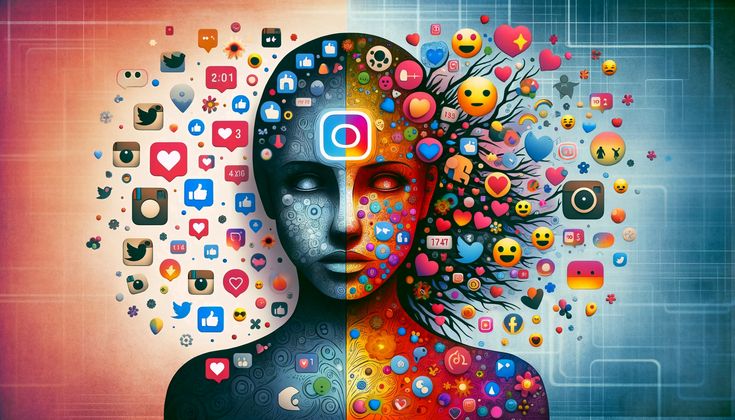Social media has revolutionized how teenagers connect, communicate, and express themselves. With platforms like Instagram, TikTok, and Snapchat dominating their daily lives, the effects of these digital interactions on mental well-being have become a growing concern. While social media offers numerous benefits, such as fostering friendships and providing educational resources, it also presents risks that can impact teen mental health. Understanding the influence of social media is essential for parents, educators, and young users themselves to create a balanced digital environment.
The Role of Social Media in Teenage Life
In today’s world, social media serves as more than just a platform for entertainment—it is a major source of information, self-expression, and social connection for teens. Many use these platforms to stay updated on trends, communicate with peers, and share their thoughts and experiences. The sense of belonging created through online interactions can be beneficial for mental health, particularly for teens who struggle with in-person socialization.
However, excessive reliance on social media for validation can lead to emotional distress. The pressure to maintain an idealized online persona often causes anxiety, stress, and insecurity. Teens may feel compelled to compare themselves to influencers and peers, fostering unrealistic expectations about body image, lifestyle, and achievements.
Social Media and Self-Esteem
One of the most significant ways social media impacts teen mental health is through its influence on self-esteem. The curated nature of online content can lead to feelings of inadequacy, as teenagers frequently compare their real lives to the highlight reels of others. This can result in negative self-perception and decreased confidence.
Moreover, the number of likes, comments, and shares a post receives often serves as a measure of self-worth for many teens. When a post does not perform well, it can trigger feelings of rejection and self-doubt. Encouraging teens to separate their self-worth from social media metrics is crucial in promoting a healthier digital experience.
Cyberbullying and Online Harassment
Social media has made it easier for teens to connect, but it has also increased the risk of cyberbullying. Unlike traditional bullying, which is limited to schools or social settings, online harassment can occur at any time and reach a wider audience. Cyberbullying can take many forms, including hurtful comments, spreading rumors, and public shaming.
The emotional toll of cyberbullying can be severe, leading to depression, anxiety, and, in extreme cases, suicidal thoughts. Teens who experience online harassment may struggle with trust issues and withdraw from social interactions. Parents and educators must encourage open communication about online experiences and provide teens with the necessary tools to handle cyberbullying effectively.
The Role of Social Media in Anxiety and Depression

Studies have shown a strong link between excessive social media use and increased anxiety and depression in teenagers. The constant stream of information, notifications, and messages can be overwhelming, leading to stress and difficulty focusing on daily activities. The fear of missing out (FOMO) also contributes to anxiety, as teens feel pressured to stay connected and engaged at all times.
Additionally, exposure to negative or distressing content can affect mental well-being. Whether it’s witnessing online arguments, reading about global crises, or encountering distressing videos, prolonged exposure to such content can create feelings of helplessness and sadness. Setting boundaries for social media use and encouraging offline activities can help mitigate these effects.
Sleep Disruptions and Its Impact on Mental Health
The use of social media before bedtime is a common habit among teens, but it can negatively impact sleep quality. The blue light emitted from screens interferes with the body’s natural sleep cycle, making it harder for teens to fall asleep and stay asleep. Poor sleep has been linked to increased stress, irritability, and difficulty concentrating in school.
Furthermore, the urge to check notifications late at night can lead to sleep deprivation, which exacerbates existing mental health issues. Encouraging healthy screen time habits, such as setting a digital curfew or using night mode, can improve sleep hygiene and overall well-being.
Strategies for a Healthier Digital Experience
While social media is deeply ingrained in modern teenage life, there are ways to minimize its negative effects on mental health. Promoting digital literacy, encouraging mindful usage, and fostering open conversations about online experiences can help teens navigate the digital world more effectively.
Setting Time Limits: Encouraging teens to set time limits on social media use can help them balance online and offline activities. Apps that track screen time can be useful in managing usage.
Following Positive Content: Encouraging teens to follow pages that promote mental wellness, personal growth, and positivity can help create a healthier online environment.
Practicing Digital Detox: Taking regular breaks from social media can help reduce stress and improve mental clarity. Engaging in offline activities such as sports, reading, or hobbies can be beneficial.
Encouraging Open Communication: Creating a safe space where teens can discuss their online experiences without fear of judgment can help them navigate challenges more effectively.
Conclusion
Social media is a powerful tool that can influence teen mental health in both positive and negative ways. While it provides opportunities for connection and self-expression, it also comes with risks that must be addressed. By fostering healthy online habits, encouraging mindful social media use, and promoting open discussions about mental well-being, teens can enjoy the benefits of digital platforms while safeguarding their mental health. Balancing social media use with real-world interactions is key to ensuring a healthier and more fulfilling teenage experience.


